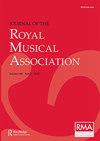Letting Beethoven’s Hair Down: Dancing and Musicking in Vienna
IF 0.5
2区 艺术学
0 MUSIC
引用次数: 0
Abstract
It feels fitting to have worked on this review in Baden bei Wien, in which Beethoven spent many summers. This pretty town southwest of Vienna boasts not only a Beethoven-Haus, but also a Beethoven-Panoramaweg, Beethoven-Rundwanderweg, Beethoven-Spazierweg, and even an imposing Beethoven-Tempel, offering a scenic view; notions of decentring, decolonizing, or even critically engaging with Beethoven’s canonic status feel not only remote, but also faintly inappropriate in this, as many other, Beethoven-designated spaces. Moreover, at the time of writing, the international press is reporting that Beethoven’s skull fragments are being returned to Vienna, as though they are holy relics.放下贝多芬的头发:维也纳的舞蹈与音乐
贝多芬曾多次在维也纳的巴登度过夏天,在这里撰写这篇评论感觉非常合适。这座位于维也纳西南部的美丽小镇不仅拥有一座贝多芬故居,还拥有贝多芬-帕诺拉玛大道(Beethoven-Panoramaweg)、贝多芬-漫游大道(Beethoven-Rundwanderweg)、贝多芬-斯帕齐耶大道(Beethoven-Spazierweg),甚至还有一座气势恢宏的贝多芬纪念碑(Beethoven-Tempel),景色宜人;在这里,以及在许多其他贝多芬指定的空间里,去中心化、去殖民化,甚至批判性地参与贝多芬的经典地位,不仅感觉遥远,而且隐隐有些不妥。此外,在撰写本文时,国际媒体正在报道贝多芬的头骨碎片被送回维也纳,就好像它们是圣物一样。1 这些贝多芬经典性的物质痕迹似乎是对试图敲打意识形态牢笼的嘲弄,然而埃里卡-布尔曼(Erica Buurman)和南希-诺维(Nancy November)最近的两本书却做出了重要贡献。前者间接地提出了贝多芬与维也纳舞蹈文化的关系问题,而后者对贝多芬交响曲室内乐编曲的论述则给人留下了深刻的印象。
本文章由计算机程序翻译,如有差异,请以英文原文为准。
求助全文
约1分钟内获得全文
求助全文
来源期刊
CiteScore
0.50
自引率
0.00%
发文量
16
期刊介绍:
The Journal of the Royal Musical Association was established in 1986 (replacing the Association"s Proceedings) and is now one of the major international refereed journals in its field. Its editorial policy is to publish outstanding articles in fields ranging from historical and critical musicology to theory and analysis, ethnomusicology, and popular music studies. The journal works to disseminate knowledge across the discipline and communicate specialist perspectives to a broad readership, while maintaining the highest scholarly standards.

 求助内容:
求助内容: 应助结果提醒方式:
应助结果提醒方式:


